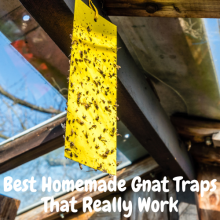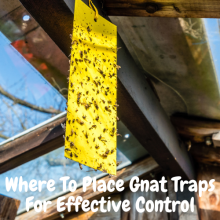Best Attractants And Baits For Gnat Traps | HelpHowTo
Summary of Best Attractants And Baits For Gnat Traps
Gnat infestations can quickly become a major nuisance, but gnat traps using attractive baits offer an effective solution. Homemade baits like rotting fruits, vinegar, yeast mixtures, and sweet or protein-rich lures take advantage of gnats’ natural attractants. Commercial traps feature pre-loaded lures, some with pheromones, and funnel trap designs. Natural attractants like plants, fermented foods, and essential oils provide eco-friendly bait options.
Proper bait placement near gnat hotspots, regular replacement, and combining attractants maximizes effectiveness. Factors like gnat species, indoor/outdoor use, smell preferences, cost, and environmental impact guide bait choice. Potential downsides include odors, attracting other pests, mess, safety concerns, and limited effectiveness if root causes aren’t addressed. Used strategically in an integrated pest management approach, the right gnat trap baits can successfully combat infestations and reclaim living spaces.

Our Top 5 Recommended Indoor Genat Traps
Sick of pesky gnats invading your home? Discover the top 5 indoor gnat traps to banish these annoying insects for good! Our expert reviews reveal the most effective, easy-to-use traps. From powerful UV attractants to eco-friendly vinegar traps, we’ve thoroughly tested and ranked the best solutions. Check Now

Battling Gnat Infestations: The Best Attractants and Baits for Effective Trapping
Gnats, those pesky little flies, can quickly turn into a major nuisance in homes and gardens. While relatively harmless, their persistent presence can be incredibly annoying and even lead to contamination of food and surfaces. Fortunately, gnat traps offer an effective solution by luring these insects in with attractive baits or lures before trapping them. In this comprehensive guide, we’ll explore the best attractants and baits for gnat traps, helping you regain control over your living spaces.
Homemade Gnat Trap Baits: Affordable and Effective
One of the most cost-effective approaches to gnat control is the creation of homemade gnat trap baits. These baits take advantage of gnats’ natural attraction to certain smells and substances, making them highly effective in luring the pests.
Fruit-based baits are a popular choice, utilizing the irresistible aroma of rotting or fermented fruits like bananas, apples, or cider vinegar. The sweet and pungent scents released by these baits mimic the natural environment gnats are drawn to, making them almost impossible to resist.
Yeast and bread-based baits are another excellent option, exploiting gnats’ attraction to fermentation smells. By creating a mixture of yeast, sugar, and water, you can create a potent lure that mimics the scent of fermenting fruits or vegetables.
For those who prefer a more straightforward approach, vinegar baits can be highly effective. The acetic acid aroma found in vinegars like apple cider or vinegar is a powerful attractant for gnats. Simply pour some vinegar into a trap, and watch as the gnats flock to the tantalizing scent.
Additionally, sweet baits made from sugar or molasses can be incredibly alluring to gnats, while protein-rich baits can target specific gnat species that are drawn to decaying organic matter.
Homemade gnat trap baits offer the added benefit of being inexpensive and readily available, making them an excellent choice for those on a budget or looking for a more natural approach to gnat control.
Commercial Gnat Trap Baits: Convenience and Variety
For those who prefer a ready-to-use solution, commercial gnat traps offer a wide range of pre-loaded baits and lures. These traps often come equipped with liquid lures or solid gel/block baits, some of which even incorporate pheromones to enhance their attractiveness to gnats.
One popular type of commercial gnat trap is the funnel trap, which employs a special design to lure gnats in while preventing their escape. These traps can be particularly effective in areas with high gnat activity.
Some commercial baits are disposable, requiring replacement once they have lost their effectiveness, while others are reusable and rely on periodic bait replacements to maintain their potency.
When choosing a commercial gnat trap bait, it’s essential to consider factors such as the specific gnat species you’re targeting, the intended use (indoor or outdoor), and personal smell preferences. Many commercial baits are designed to be less pungent than their homemade counterparts, making them more suitable for indoor use.
Natural Gnat Attractants: Eco-Friendly Options
For those seeking a more eco-friendly approach to gnat control, a variety of natural substances can be used as effective attractants. Plant-based attractants, like certain herbs or fruits, can be appealing to gnats and offer a more natural alternative to synthetic baits.
Fermented foods, such as overripe fruits or vegetables, can also be used as gnat attractants, capitalizing on the insects’ attraction to fermentation aromas.
Essential oils and essential oil blends have also gained popularity as natural gnat attractants. Certain oils, like lemongrass or eucalyptus, are known to be particularly effective in luring gnats.
While natural attractants may not be as potent as some commercial or homemade baits, they can be a great option for those looking to minimize their environmental impact or avoid harsh chemicals.
Tips for Using Gnat Trap Baits Effectively
To maximize the effectiveness of gnat trap baits, proper use and placement is crucial. Strategic placement near gnat hotspots, such as areas with standing water, decaying organic matter, or heavily planted areas, can significantly increase the traps’ effectiveness.
Regular replacement of baits is also essential, as they can dry out or lose their potency over time. Combining complementary attractants can also be a powerful strategy, as different baits may appeal to different gnat species or life stages.
In some cases, using multiple trap types together can be beneficial, as gnats may be drawn to different attractants or trap designs. However, it’s important to consider safety precautions when using certain baits, especially around children or pets.
Choosing the Right Bait: Factors to Consider
Selecting the appropriate gnat trap bait is crucial for successful elimination efforts. The ideal bait will depend on several factors, including the specific gnat species you’re targeting, whether the trap will be used indoors or outdoors, personal smell preferences, and cost considerations.
Different gnat species may be attracted to different types of baits. For example, fruit flies may be more drawn to fruit-based baits, while fungus gnats may prefer protein-rich or yeast-based attractants.
Indoor use may require baits with milder or less pungent smells, while outdoor traps can often accommodate stronger-scented baits without issue.
Cost can also be a factor, with homemade baits generally being more affordable than commercial options. However, commercial baits may offer greater convenience and consistency.
Environmental impact is another consideration, with natural attractants often being favored by those seeking a more eco-friendly approach to gnat control.
Downsides of Gnat Trap Baits
While gnat trap baits can be highly effective in controlling infestations, there are some potential downsides to be aware of:
- Smell: Some baits, particularly those made from rotting fruits or fermented materials, can produce strong and unpleasant odors. This can be a nuisance, especially when used indoors.
- Attracting Other Pests: In addition to gnats, some baits may inadvertently attract other insects or pests, such as ants or flies, which can exacerbate the problem.
- Mess: Certain liquid or semi-solid baits can be messy, potentially spilling or leaking if not handled properly.
- Safety Concerns: Some baits may contain ingredients that are potentially harmful if ingested by children or pets, requiring extra caution in their use and storage.
- Limited Effectiveness: While baits can be highly effective, they may not fully eliminate a gnat infestation if the root cause (e.g., standing water, decaying organic matter) is not addressed.
To mitigate these downsides, it’s important to carefully follow instructions for bait use, storage, and disposal, and to consider using baits in conjunction with other gnat control methods as part of an integrated pest management (IPM) approach.
Conclusion
Gnat infestations can quickly become a frustrating and persistent problem, but with the right attractants and baits, effective control is possible. Whether you opt for homemade, commercial, or natural options, choosing the appropriate bait for your specific situation is key to successful elimination.
By understanding the preferences and behaviors of different gnat species, utilizing strategic placement and bait replacement, and considering factors like personal preferences and environmental impact, you can effectively combat gnat infestations and reclaim your living spaces.
Remember, while gnat trap baits can be highly effective, they should be used as part of an integrated pest management (IPM) approach that addresses the root causes of the infestation. By combining baits with other control methods, such as eliminating standing water or decaying organic matter, you can achieve long-term, sustainable gnat control.

Our Top 5 Recommended Indoor Genat Traps
Sick of pesky gnats invading your home? Discover the top 5 indoor gnat traps to banish these annoying insects for good! Our expert reviews reveal the most effective, easy-to-use traps. From powerful UV attractants to eco-friendly vinegar traps, we’ve thoroughly tested and ranked the best solutions. Check Now
FAQs and Answers
Are there any specific baits or attractants that work best for certain species of gnats, like fungus gnats or drain flies?
Yes, certain baits and attractants tend to work better for specific species of gnats:
Fungus Gnats:
- These gnats are attracted to fermenting or decaying organic matter where fungus grows. Effective baits include:
- Potato pieces or other decaying vegetables
- Cornmeal or moldy bread
- Yeast/sugar water mixtures
- Vinegar traps (apple cider vinegar works well)
Drain Flies:
- Also called moth flies or sink flies, these small gnats breed in the slime and organic matter that builds up in drains.
- Inexpensive drain cleaners like baking soda and vinegar can help remove breeding sites.
- Ripe fruits or sweet baits like honey can attract adults to traps.
- Some pheromone lures specifically for drain flies are available.
Fruit Flies:
- As their name implies, fruit flies are attracted to overripe or fermenting fruits and vegetables.
- Vinegar, and rotting fruit make excellent fruit fly baits.
- Yeast and sugar water mixtures also work well.
So in summary, sugary, fermenting, and decomposing plant matter baits tend to be most effective for fungus gnats and fruit flies, while drain flies may need more specialized pheromone lures or removal of their breeding areas. Using the right attractant matched to the species is key.
How long do different types of baits typically remain effective before needing replacement or refreshing?
The effective lifespan of different gnat trap baits can vary quite a bit depending on the type of bait used:
Liquid Baits:
- Vinegar baits – About 1-2 weeks before they start drying out
- Fruit juice baits – 3-5 days before mold/fermentation makes them unattractive
Solid/Semi-Solid Baits:
- Overripe/rotting fruit – 5-10 days depending on the fruit
- Bread/yeast baits – 7-14 days
- Molasses or sugar baits – 2-3 weeks
Commercial Lures:
- Liquid lures – 30 days is typical before needing replacement
- Solid lures/pheromones – Can last 2-6 months
Natural Attractants:
- Fresh plant materials – 3-7 days
- Essential oil blends – 2-4 weeks
In general, most homemade liquid and solid baits need refreshing every 1-2 weeks as they dry out or rot away. Commercial lures last longer, from 1-6 months typically. Natural plant attractants are on the shorter side of 3 days to 1-2 weeks.
No matter the bait, it’s important to keep an eye out for drying, molding, or foul smells which indicate it has turned unappetizing to gnats and needs replacement. Consistent bait refreshing is key for continued effectiveness.
Can bait traps be used as a preventative measure against gnat infestations, or are they only effective once an infestation has already occurred?
Bait traps can be used both as a preventative measure against gnat infestations as well as for controlling existing infestations. However, their effectiveness differs slightly in each scenario:
As a Preventative Measure:
Using gnat bait traps proactively can help stop small populations of gnats from establishing and growing into full-blown infestations. This is especially useful in areas prone to gnats like kitchens, gardens, or near drains/moisture sources.
The traps lure in and eliminate the initial gnats that find their way indoors or into your space before they can breed and multiply. This early intervention prevents the gnat numbers from reaching infestation levels.
Proper placement of traps in common gnat entry points or hotspots is key for prevention. Regular bait maintenance is also required to ensure the traps remain consistently attractive.
For Existing Infestations:
When a full gnat infestation has already taken hold, bait traps become more of a control and elimination method rather than prevention. The traps help reduce high gnat populations by luring them in and capturing them.
However, traps alone are often not enough to completely eliminate an entrenched infestation. They need to be used in conjunction with efforts to remove the gnat breeding sources like rotten produce, standing water, or organic debris.
So in summary – bait traps can play a preventative role by stopping small gnat populations before they escalate. But for active infestations, they are most effective when combined with other remediation steps to cut off the infestation at its source.
Are there any tips for safely disposing of used bait materials to avoid attracting additional pests or creating odor issues?
Yes, there are some important tips for safely and properly disposing of used gnat trap baits to avoid attracting more pests or creating odor issues:
- Use sealed disposable bags or containers
When it’s time to replace used bait materials, make sure to seal them up tightly in a plastic bag or lidded container before disposal. This prevents any lingering odors from escaping and luring in more insects. - Opt for freezer disposal
Rather than just tossing bait remains in the regular trash, it’s best to place them in a sealed bag and put them in the freezer for 24-48 hours first. This kills any insect eggs or larvae that may be present. - Avoid sink/drain disposal
Never dump liquid baits or bait remains down sink or floor drains, as this can clog pipes and provide breeding spots for drain flies and other pests. - Clean trap thoroughly
For reusable traps, thoroughly wash out with soap and hot water after disposing of the old bait to remove any residue that could attract more gnats. - Use baking soda
Sprinkling some baking soda in the trash can help absorb and neutralize strong odors from rotting bait materials. - Take trash out promptly
Don’t let bait-filled trash bags sit around inside for long. Take them straight out to the outdoor bins to prevent odor issues indoors.
Proper disposal is important both to avoid creating new pest problems as well as keeping offensive smells from lingering in your home after trap use. A little care goes a long way.
Some baits can be quite pungent – are there any tricks for minimizing offensive odors when using smelly attractants indoors?
Using pungent gnat baits indoors can definitely be a bit of an odor issue. Here are some tips to help minimize offensive smells when using smelly attractants inside:
- Go for milder baits
For indoor use, opt for baits with milder scents like fruit juices, mild vinegars, or commercial lures rather than rotten fruits or fermenting mixtures which tend to be smellier. - Use less bait
You only need a small amount of bait to be effective. Use the minimum required to reduce odor. - Double containment
Place the bait trap inside a larger sealed container with holes for gnats to enter. The outer container helps contain odors. - Ventilate the area
If possible, set up gnat traps near windows or areas with good airflow to ventilate odors outside. - Add odor absorbers
Place bowls of baking soda, activated charcoal, or odor-absorbing gels near the traps to help neutralize smells. - Use essential oils
Add a few drops of essential oils like lemongrass or peppermint near the trap to help mask funky scents. - Replace baits frequently
Don’t let smelly baits fester. Replace them frequently, every 3-5 days for the worst offenders. - Try odorless dry traps
For continual indoor use, switch to odorless dry traps with pheromone lures after the initial infestation is cleared.
A bit of creativity with containment, neutralizers, and proper bait rotation can go a long way in reducing unpleasant indoor odors from gnat baits.

Our Top 5 Recommended Indoor Genat Traps
Sick of pesky gnats invading your home? Discover the top 5 indoor gnat traps to banish these annoying insects for good! Our expert reviews reveal the most effective, easy-to-use traps. From powerful UV attractants to eco-friendly vinegar traps, we’ve thoroughly tested and ranked the best solutions. Check Now





